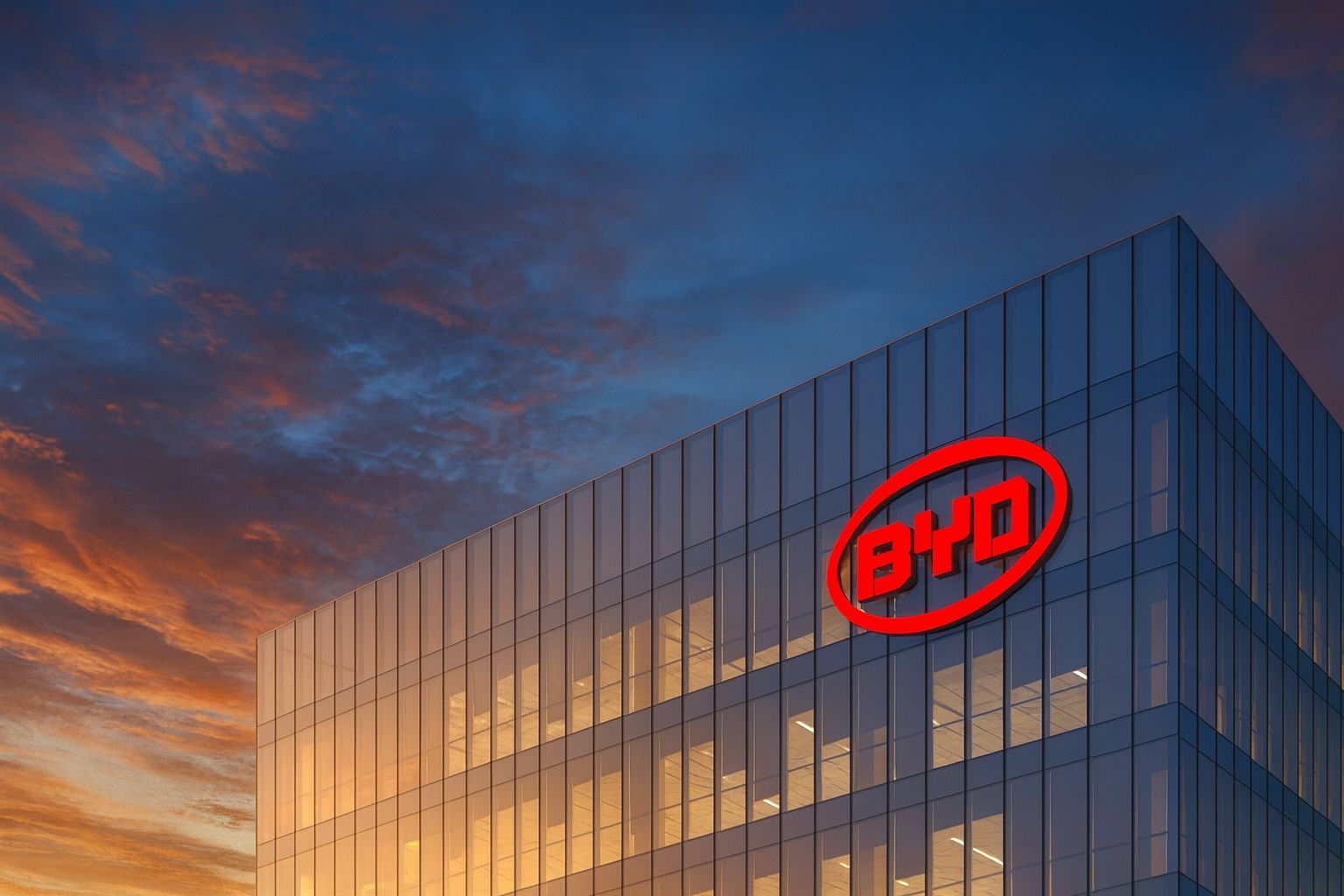- Stock Price: BYD’s Hong Kong stock (1211.HK) opened at about HK$104.20 on Oct. 30, 2025 [1], roughly unchanged from the previous day. Its U.S. ADR trades around $13 (13.02 at mid‐day Oct. 30) after a recent peak in May [2] [3]. After climbing earlier this year, BYD shares have slid about 30% from their May highs [4].
- Recent News: On Oct. 30, BYD reported a 32.6% drop in Q3 net profit (to ¥7.8 B) and a 3.1% revenue decline to ¥195 B [5] – its first earnings fall in five years. The company has also cut its 2025 sales target 16% to 4.6 million vehicles [6]. These results fueled investor jitters amid an intense domestic EV price war [7] [8].
- Domestic Market: BYD’s China sales stalled – Q3 deliveries fell for the first time since 2020 [9] [10]. Competition from Geely, Leapmotor, Xiaomi and others gained share, and Chinese regulators ordered an end to “irrational” price cuts [11] [12].
- Global Expansion: Abroad, BYD is booming. Registrations in Europe jumped nearly fivefold in Sept. 2025 (about 25,000 cars) [13], even briefly outselling Tesla in some markets. BYD is opening new plants in Hungary and Turkey and expanding in Latin America and Japan [14] [15].
- Analyst Sentiment: Wall Street still leans bullish. Major firms like Morgan Stanley, Nomura and HSBC have buy ratings on BYD, with average HK$ price targets around HK$204 (implying ~100% upside) [16]. Analysts note BYD’s huge global scale and note that a stock dip may be a “buy-the-dip” opportunity [17] [18]. However, cautions abound that growth may moderate as the price war bites [19] [20].
BYD Shares: Price and Recent Moves
BYD’s stock has experienced a sharp correction in recent months. In early 2025 the Hong Kong-listed shares hit record highs (above HK$150 in May), but by late October they traded near HK$104 [21] – roughly 30% below the peak [22]. This slide erased tens of billions in market value. For example, Bloomberg reports the company lost over $45 billion of market cap as stock slid 32% from May to October [23].
Investors have blamed weaker-than-expected earnings and slowing growth in China. On Oct. 29, trading ahead of the earnings release, BYD’s Hong Kong shares rose slightly (around +1.63% on Oct. 27) [24] as some traders hoped for a rebound. But by Oct. 30, after news of the large profit drop, sentiment soured. Over the past few weeks the stock actually marked its fifth straight month of losses, the longest streak since 2018 [25]. Even so, analysts note that price targets remain far above current levels (TipRanks shows most analysts at “buy” with targets around HK$200) [26], suggesting many see the pullback as overdone.
Recent News: Profit Woes and Price War
On Oct. 30, BYD’s Hong Kong-listed (H-share) unit announced that Q3 net income fell to ¥7.82 billion – a 32.6% year-on-year drop – and revenue slid 3.1% [27]. This was BYD’s biggest quarterly profit fall in over four years, and marked its first revenue decline in five years [28]. The filings attributed the slump largely to a fierce price war in China and cooling demand. To defend share, BYD offered hefty discounts on popular models (e.g. the Qin Plus sedan) last month [29].
Chinese media report that BYD’s market share in China has fallen – down to ~14% in September from 18% a year earlier [30]. Rivals like Geely, Leapmotor and Xiaomi have aggressively cut prices and introduced new models, chipping away at BYD’s once-dominant position [31] [32]. In response to the industry-wide price war, Beijing’s regulators in mid-2025 cracked down on “irrational” deep discounts and even forced BYD to speed up payments to suppliers [33] [34].
Meanwhile, BYD continues its global push. On Oct. 27–28, press reports highlighted BYD’s explosive growth in Europe. For example, industry data show BYD’s European EV registrations jumped roughly five-fold year-over-year in Sept. 2025 [35]. That surge means BYD is closing in on market share in key countries; in the EU BYD sold over 13,000 cars in Sept., triple its volume a year ago [36]. (By contrast, Tesla’s European sales fell: one report notes a double-digit drop in EU registrations for Tesla in that period [37].) To meet overseas demand, BYD is localizing production – plants are under construction or planned in Hungary (operational late 2025), Turkey (2026) and Brazil [38]. The company even previewed a made-for-Japan mini-EV this week, debuting at the Tokyo Mobility Show [39]. These expansion moves underscore BYD’s strategy to offset China weakness with booming exports.
Business Developments: Sales, Products and Strategy
Domestic challenges: After years of torrid growth, BYD’s China deliveries have peaked. The Business Times reports BYD saw its first year-on-year sales decline in a quarter since 2020 in Q3 [40]. Seasonal weakness and intensifying competition forced BYD to slash its 2025 sales goal from 5.5 M to about 4.6 M vehicles [41] [42]. The company blamed pricing and model strategies: it delayed some new-car launches to early 2026 to make them more competitive [43], while continuing to adjust line-ups. BYD’s hybrid sales (PHEVs) remain strong: plug-in hybrids now make up ~30% of China’s EV market [44], and BYD has dozens of models in that segment (e.g. Tang, Qin, Seal PHEV). This hybrid strength is seen as a buffer in case full-EV demand softens.
Global push: Outside China, BYD is aggressively growing. Already the world’s top EV seller by volume (surpassing Tesla in 2024 [45]), BYD is leveraging its brand abroad. In Latin America, BYD’s first plant in Brazil came online (150k initial capacity) [46]. In Southeast Asia, a Thai factory (150k capacity) started in 2024. The company aims for “double” overseas sales in 2025 vs. 2024 [47]. S&P Global forecasts BYD could sell 1 million vehicles overseas in 2025 [48], far beyond its own targets. Key new markets include Japan (tiny EV market until now), Europe (especially hybrids), and even the US indirectly through partnerships (e.g. Toyota collaboration on EVs). These global efforts have supported BYD’s revenue: H1 2025 revenue was US$51.9 B, already exceeding Tesla’s $41.8 B [49], illustrating BYD’s enormous scale.
Manufacturing and tech: BYD touts its vertical integration as a “moat.” It makes its own batteries (the Blade battery), motors and chips. The company is adding capacity: besides overseas plants, BYD continues to build mega-factories in China and is expanding battery output. Its build-out into plug-in hybrids is particularly notable: TS2 analysts point out BYD’s hybrids could even outsell pure EVs in Europe as customers there seek a practical alternative [50]. Executive statements reflect confidence: BYD VP Stella Li told Reuters, “BYD’s growth in 2025 will be driven by sales outside China” [51].
Broader EV Market Trends
The backdrop for BYD’s struggles and opportunities is a rapidly evolving global EV market. Worldwide, EV sales continue to rise, but the pace and geography are shifting. The IEA reports global electric car sales topped 17 million in 2024 (a >25% jump) [52], with China accounting for ~11 million (two-thirds of the global total) [53]. In China, EVs now make up nearly half of all new car sales [54], but growth has recently cooled. Subsidies and a new trade-in incentive briefly spiked demand, but policy support is fading. Europe’s EV adoption has stalled, as many governments scaled back purchase incentives in 2024 [55]. EVs are roughly 20% of new cars in Europe, with several big markets flat or down year-on-year [56].
One notable trend is the rise of plug-in hybrids (PHEVs). In China, PHEVs have grown to about 30% of electric car sales (up from 15% in 2020) [57], while “extended-range” EVs quadrupled their share. BYD, which has many affordable PHEVs, is positioned to benefit. In Europe, hybrid models (like the BYD Dolphin PHEV) are also increasingly popular amid charging infrastructure concerns [58]. At the same time, legacy automakers in Europe and the US are under pressure: buyers favor cost-effective EVs and hybrids over premium models, putting incumbents in a tough spot [59] [60].
The Chinese market’s aggressive price competition is another big trend. In 2024–25, numerous Chinese EV makers (including Tesla’s China unit) slashed prices, triggering a cutthroat “race to the bottom.” Bloomberg and TS2 reports highlight that by mid-2025 China’s average EV prices had fallen nearly 19% over two years [61]. Regulators have since stepped in, but margins are squeezed. BYD’s competitors, from Xiaomi to Leapmotor, have hungry capital and are willing to undercut BYD’s pricing. This structural shift – normalization of EV pricing – partly explains why BYD’s blistering growth has cooled. Analysts note we’re moving from a subsidy-fueled boom to more sustainable (and slower) growth across the industry.
Expert Commentary & Forecasts
Despite short-term pains, many analysts remain upbeat on BYD. A Reuters summary quotes experts saying “fundamentals remain strong” and several brokerages reaffirming “buy” ratings [62] [63]. For example, TipRanks shows 7 of 9 analysts rate BYD stock as a buy [64]. Morgan Stanley explicitly calls the recent sell-off a “buy-the-dip” setup: MS analysts highlight that BYD’s inventory glut (built up during the summer slowdown) is now easing, and heavy short interest could drive a “self-reinforcing rebound” when sales pick up [65] [66]. They forecast BYD’s overseas sales jumping to 1.6–1.8 million units in 2026 (nearly 70–90% growth year-over-year) thanks to new factories and new models [67].
Other strategists echo this. TS2 notes that Morgan Stanley and Nomura have reiterated buy calls with price targets well above current levels [68]. HSBC analysts (via Bloomberg/BusinessTimes) say BYD’s 2026 product roadmap – including a major technology upgrade – could reignite growth [69]. Even after the profit miss, one TS2 analyst reminds readers that BYD still has “double-digit revenue growth in 2025 and leadership positions in batteries and hybrids” [70]. They also point out BYD trades at a much lower P/E than Tesla [71], suggesting room to recover if margins improve.
However, bears have their points. BYD’s rapid expansion means execution risk: Morgan Stanley cautions no single foreign market will deliver massive volume – success will require a “broad-based” push across Europe, Asia and beyond [72] [73]. Jefferies warns that BYD’s once-formidable “moat” has weakened under the price war, and that underperformance may continue until momentum returns [74]. Investor sentiment is fragile: sell calls on BYD rose to the highest since 2022 amid its market‐cap wipeout [75]. On Oct. 29, a Bloomberg story highlighted that BYD was headed for its first five-month losing streak since 2018 [76], reflecting such caution.
Yet many experts still emphasize BYD’s strengths: its vertical integration, scale and cash-rich balance sheet. As TS2 notes, BYD’s new plants (e.g. Hungary) and massive production pipeline create a formidable growth platform [77]. Analyst Kevin Net (Fondis) comments that BYD’s pricing strategy will pressure margins in the short run, but in the long term its cost advantage and hybrid lineup could yield steady gains [78]. In the words of TS2’s outlook: “BYD remains a must-watch EV titan” – a leader in electrification whose stock dip may simply pause rather than end its trend [79].
Competition: Tesla, NIO and Others
BYD’s tumble has come even as its Chinese rivals shine. Domestic pure-play EV makers are on more solid footing: for instance, NIO Inc. reported record Q3 deliveries (87,071 cars, +40.8% YoY) [80], sending its stock up and giving confidence in premium Chinese EV demand. XPeng and Li Auto are also growing rapidly (driven largely by strong SUV sales). BYD, by contrast, remains the volume leader (targeting 4.6 M vs. NIO’s few hundred thousand) [81], but investors are now weighing its scale against near-term profitability.
Globally, Tesla is arguably BYD’s most-watched competitor. Tesla’s U.S. stock has underperformed many tech giants this year (up only ~9% YTD [82]) and is feeling margin pressures. Recent Reuters reports note Tesla has cut prices and introduced cheaper Model Y/3 variants to counter slowing demand [83] [84]. Tesla’s margins were squeezed by higher costs and lower regulatory credit earnings in Q3 [85]. In Europe, Tesla actually saw a sales decline (over 10% down last month) as BYD’s hybrids gained ground [86]. Nonetheless, Tesla’s brand and future-tech narrative (robotaxis, AI, etc.) mean its valuation remains sky-high (trading above 200× forward EPS [87]). In comparison, BYD’s valuation is much lower, reflecting tempered expectations.
In sum, BYD competes on different terrain: it dominates mass-market EVs and hybrids (including buses and trucks) in China, while Tesla targets premium EVs globally. TS2 analysts highlight this “different flavor” of EV play: BYD’s vertical integration and hybrid focus vs. Tesla’s tech-centric play [88]. Even in China, Tesla’s local unit has lost share to homegrown firms like BYD, which is why Tesla has now set up a local R&D center and ramped local production of its cheaper models.
Investor Sentiment, Valuation and Catalysts
Overall investor sentiment on BYD has swung to cautious. As one Bloomberg headline put it, “Earnings doubts reign” heading into Q3 results [89]. Short sellers have piled on: TS2 notes heavy short interest and suggests a potential short-covering rally if conditions improve [90]. Major shareholders also stirred nerves: Berkshire Hathaway (Buffett) sold its last BYD shares in mid-2025 (a $9 B stake), triggering a brief sell-off [91] [92]. BYD’s management has downplayed this as normal portfolio rebalancing.
On valuation, BYD’s forward P/E is now far below Tesla’s (Tesla trades at >50x forward EPS, BYD much lower) [93] [94]. Some say the selloff has “made valuations compelling” [95]. Buffett’s exit ironically improved liquidity and PR? Perhaps, but it also forced BYD into a Hong Kong share sale in March 2025 (to raise ~$5.2 B) [96] to fund R&D and expansion – diluting investors. Still, BYD’s balance sheet remains strong.
Catalysts to watch: Analysts point to a few triggers for a rebound. First, new models and tech updates in late 2025/2026 (e.g. a next-gen Dolphin or Ocean sedan, and more hybrid variants) could revive sales. Second, ramp-up of overseas plants (Hungary plant end-2025 [97], Turkey 2026) will cut costs and improve margins. Third, China’s regulatory clampdown on price war (ending deep discounts) may actually benefit BYD by stabilizing the market and propping up industry profitability. Finally, global EV demand trends – such as European subsidies reinstatement or big fleet electrification programs – could lift BYD’s foreign sales.
Outlook: In the near term, BYD may remain volatile. Trade tensions (rare earth export controls, U.S. tariff talk) and China’s economic trajectory will influence sentiment. TS2 predicts weaker EV startups will fade, leaving leaders like BYD, NIO and Li Auto to fight it out [98]. Over the medium term, most experts still view BYD as a leader with a wide moat: massive scale, vertical integration, and diversified products. As TS2 puts it, “BYD remains a must-watch EV titan” [99]. For investors, the key question is whether the current pullback is a buying opportunity. With analysts’ average targets implying roughly 100% upside from today’s levels [100] [101], many see BYD as a strong long-term EV play – provided the company can navigate the near-term price war and maintain profitability.
Sources: Official filings, Bloomberg, Reuters, TS2.tech analysis, Investing.com, Business Times, IEA report, and others as cited above. These sources provide the latest data and expert commentary on BYD’s stock, business trends, and the EV industry.
References
1. www.reuters.com, 2. www.reuters.com, 3. stockanalysis.com, 4. www.bloomberg.com, 5. www.reuters.com, 6. www.reuters.com, 7. www.reuters.com, 8. www.businesstimes.com.sg, 9. www.reuters.com, 10. www.businesstimes.com.sg, 11. www.reuters.com, 12. www.businesstimes.com.sg, 13. www.investing.com, 14. ts2.tech, 15. www.investing.com, 16. ts2.tech, 17. ts2.tech, 18. www.investing.com, 19. ts2.tech, 20. ts2.tech, 21. www.reuters.com, 22. www.bloomberg.com, 23. www.bloomberg.com, 24. www.reuters.com, 25. www.bloomberg.com, 26. ts2.tech, 27. www.reuters.com, 28. www.reuters.com, 29. www.reuters.com, 30. www.reuters.com, 31. www.businesstimes.com.sg, 32. ts2.tech, 33. www.businesstimes.com.sg, 34. ts2.tech, 35. www.investing.com, 36. www.investing.com, 37. www.investing.com, 38. ts2.tech, 39. www.reuters.com, 40. www.businesstimes.com.sg, 41. www.reuters.com, 42. www.businesstimes.com.sg, 43. ts2.tech, 44. www.iea.org, 45. ts2.tech, 46. ts2.tech, 47. ts2.tech, 48. ts2.tech, 49. ts2.tech, 50. ts2.tech, 51. ts2.tech, 52. www.iea.org, 53. www.iea.org, 54. www.iea.org, 55. www.iea.org, 56. www.iea.org, 57. www.iea.org, 58. www.investing.com, 59. www.investing.com, 60. www.reuters.com, 61. ts2.tech, 62. ts2.tech, 63. www.investing.com, 64. ts2.tech, 65. www.investing.com, 66. ts2.tech, 67. www.investing.com, 68. ts2.tech, 69. www.businesstimes.com.sg, 70. ts2.tech, 71. ts2.tech, 72. ts2.tech, 73. www.investing.com, 74. ts2.tech, 75. ts2.tech, 76. www.bloomberg.com, 77. ts2.tech, 78. ts2.tech, 79. ts2.tech, 80. www.nio.ae, 81. ts2.tech, 82. www.reuters.com, 83. www.investing.com, 84. www.reuters.com, 85. www.reuters.com, 86. www.investing.com, 87. www.reuters.com, 88. ts2.tech, 89. www.bloomberg.com, 90. ts2.tech, 91. ts2.tech, 92. www.businesstimes.com.sg, 93. www.reuters.com, 94. ts2.tech, 95. ts2.tech, 96. www.reuters.com, 97. ts2.tech, 98. ts2.tech, 99. ts2.tech, 100. ts2.tech, 101. ts2.tech







